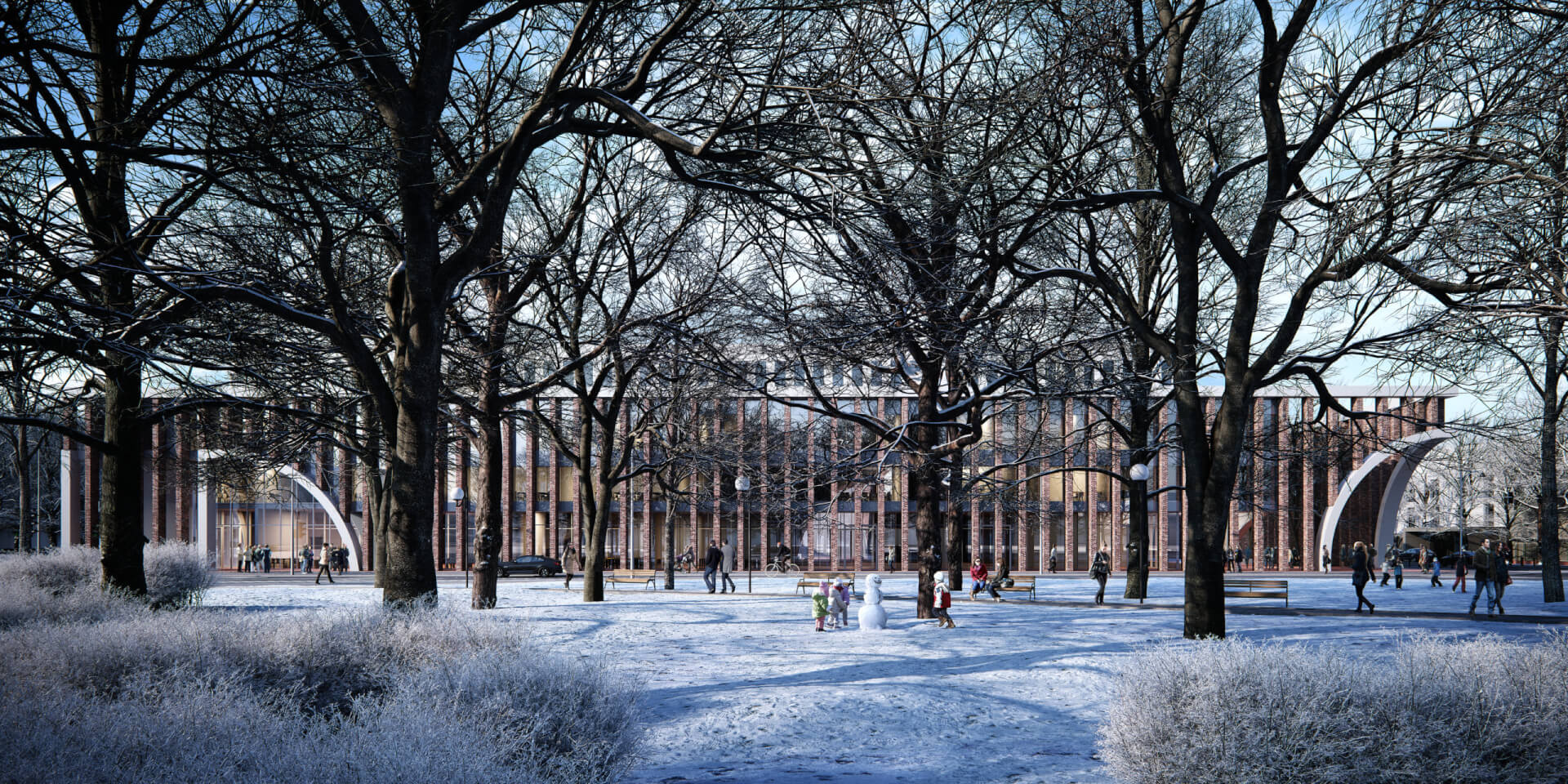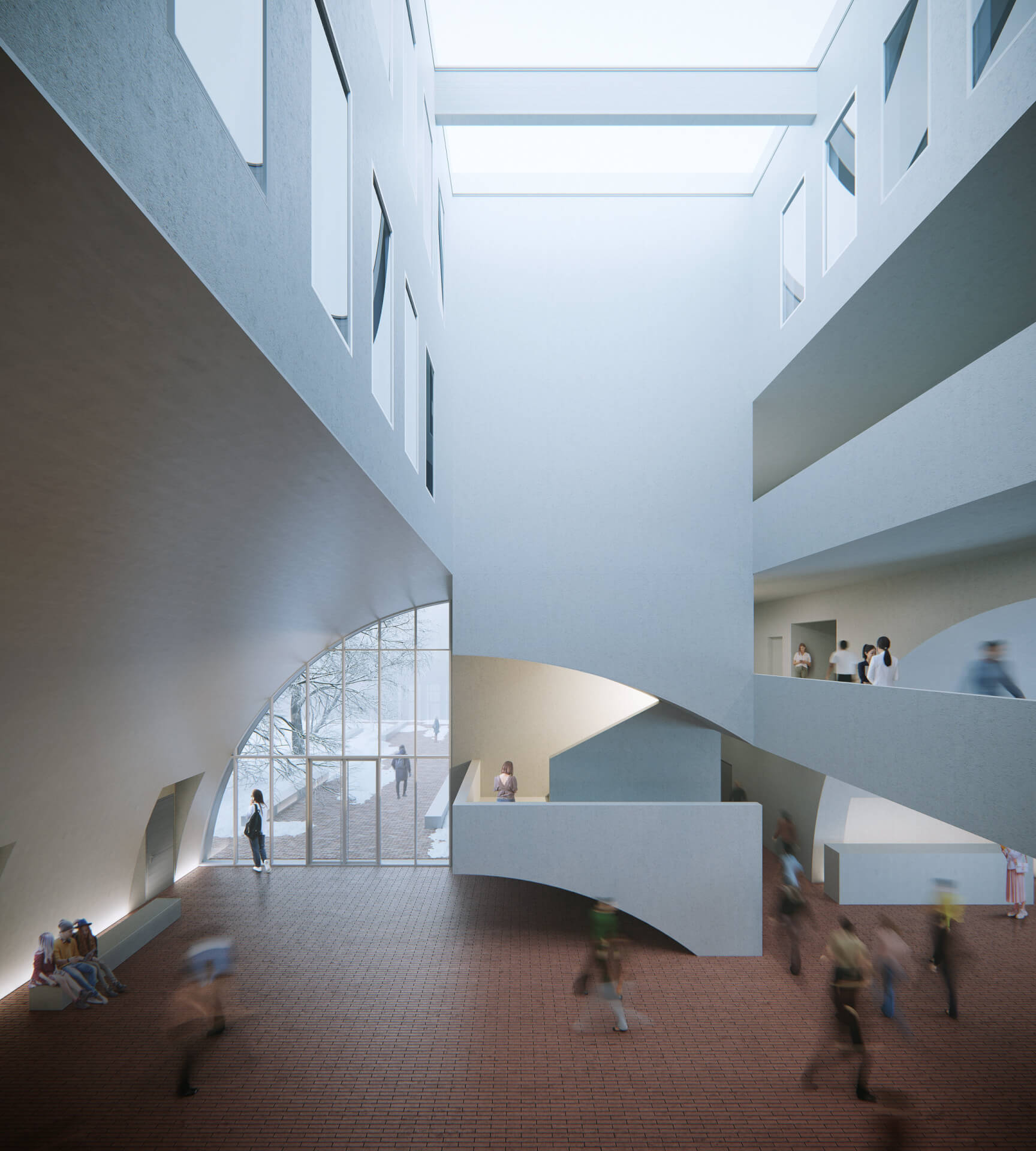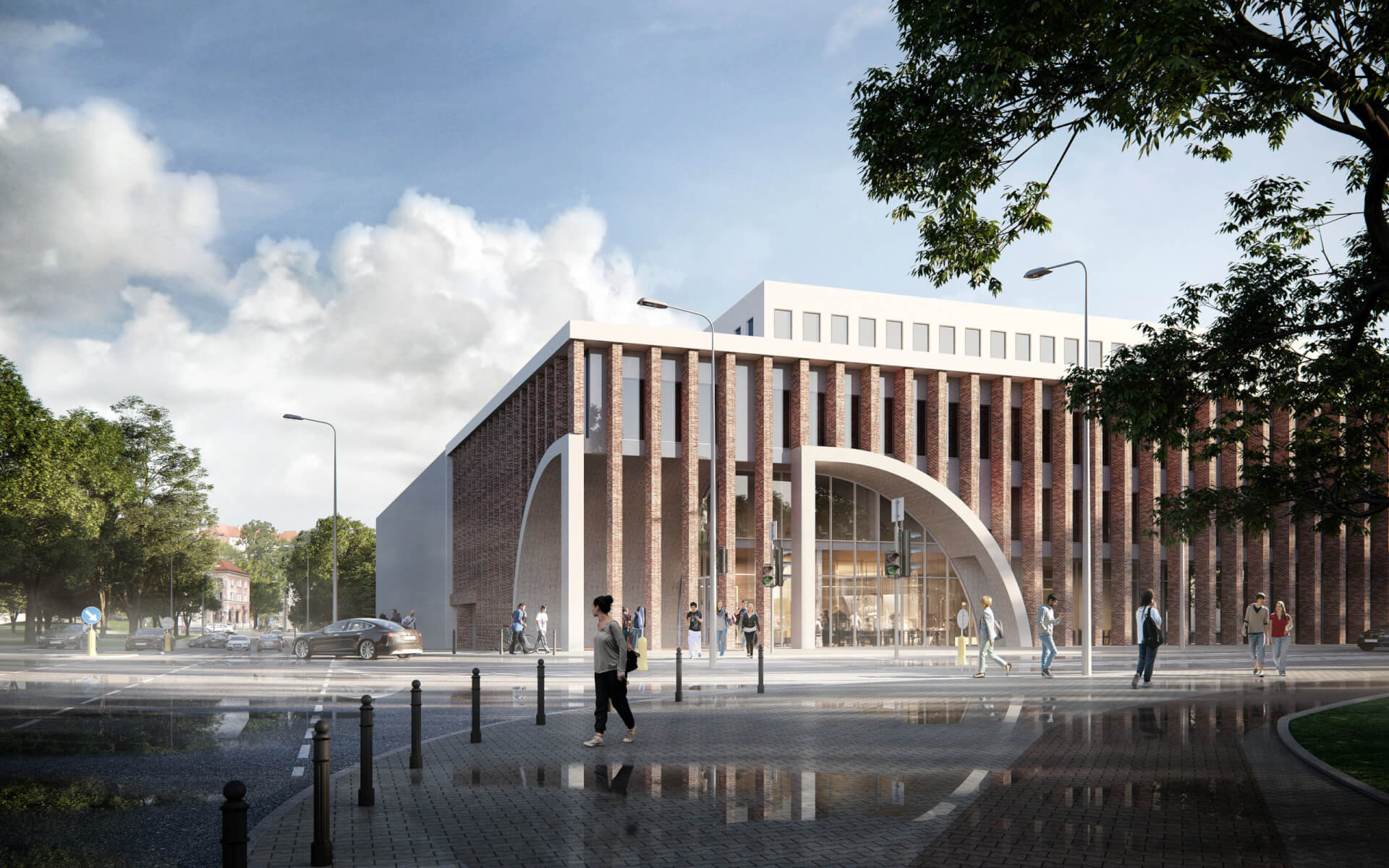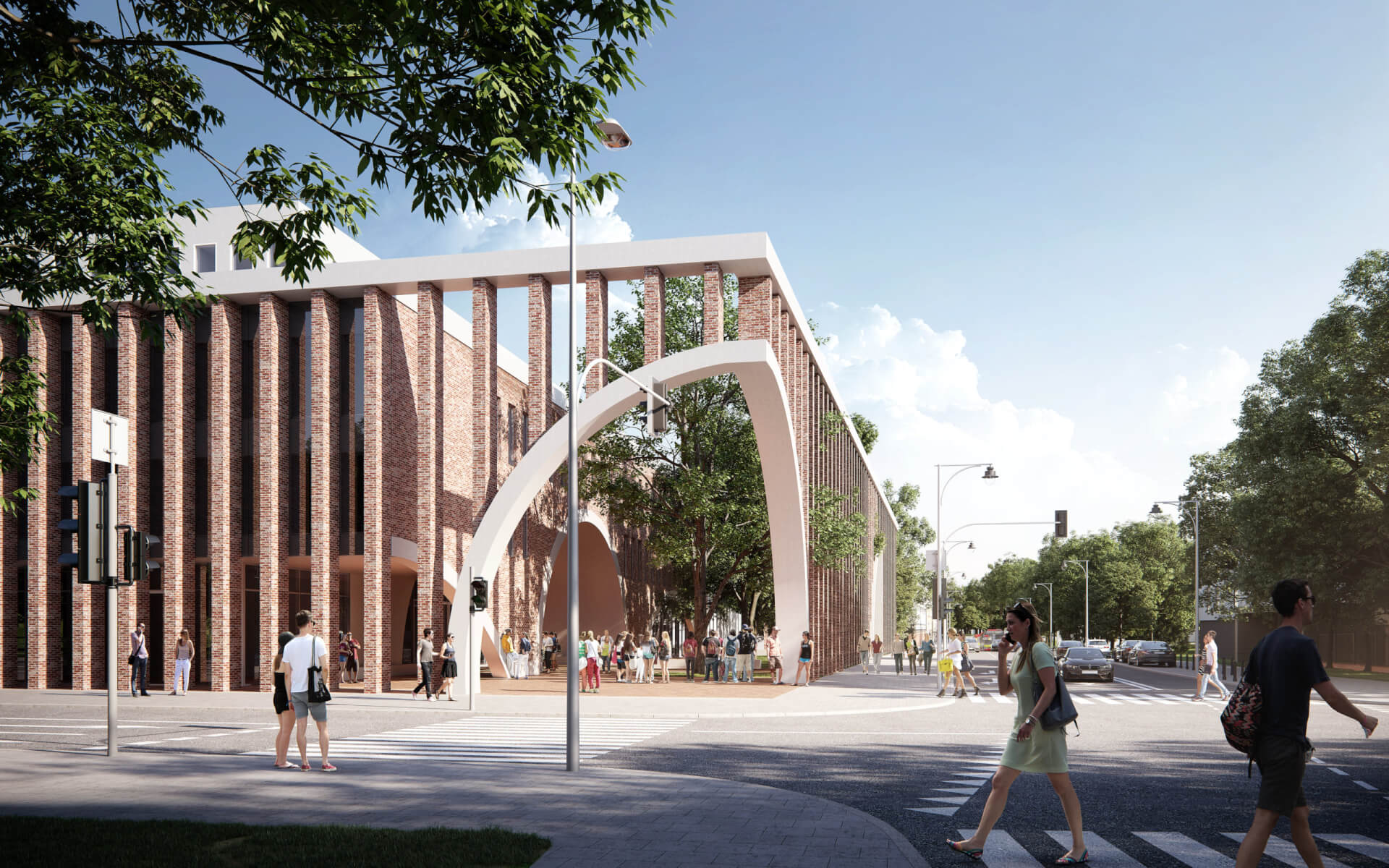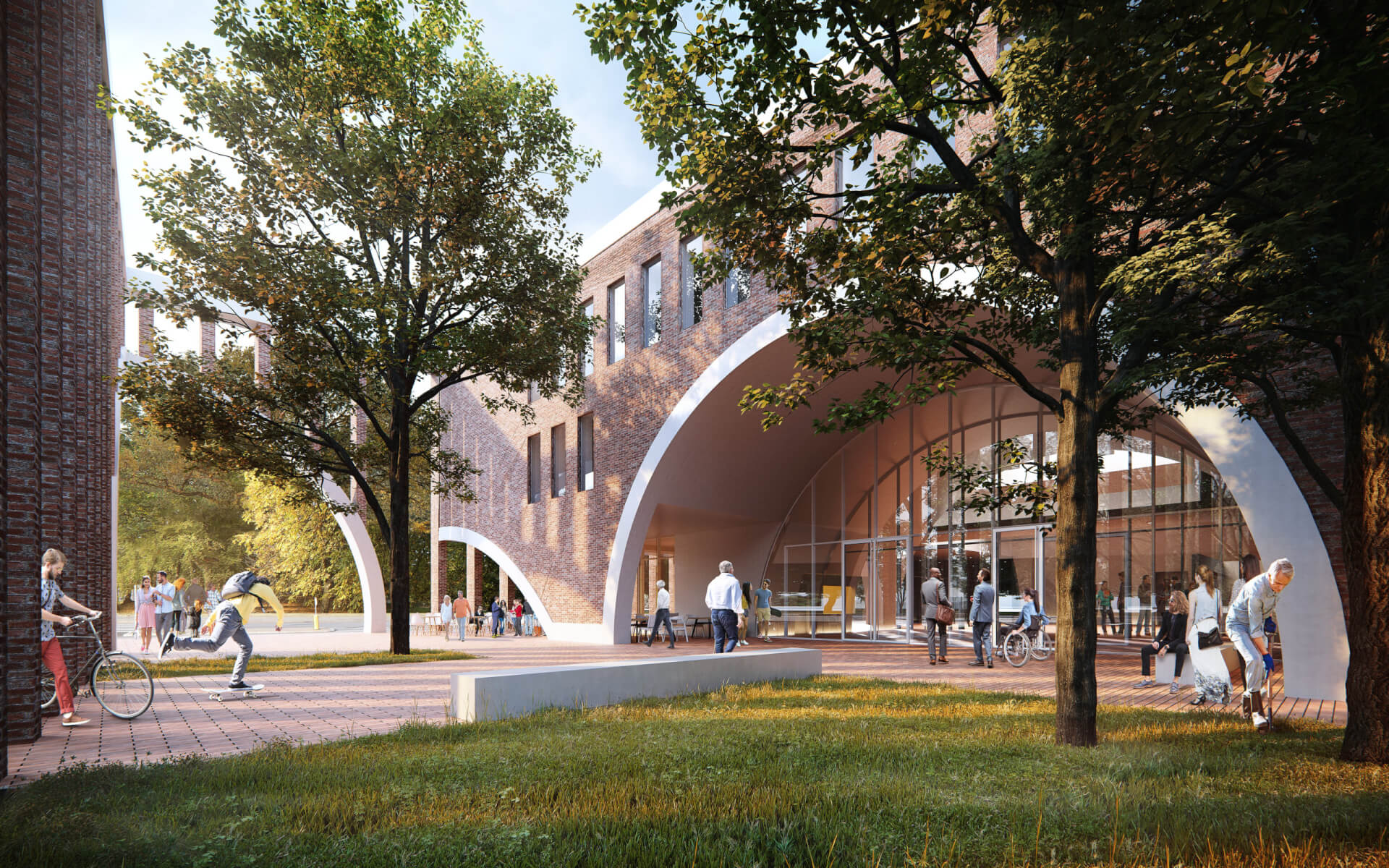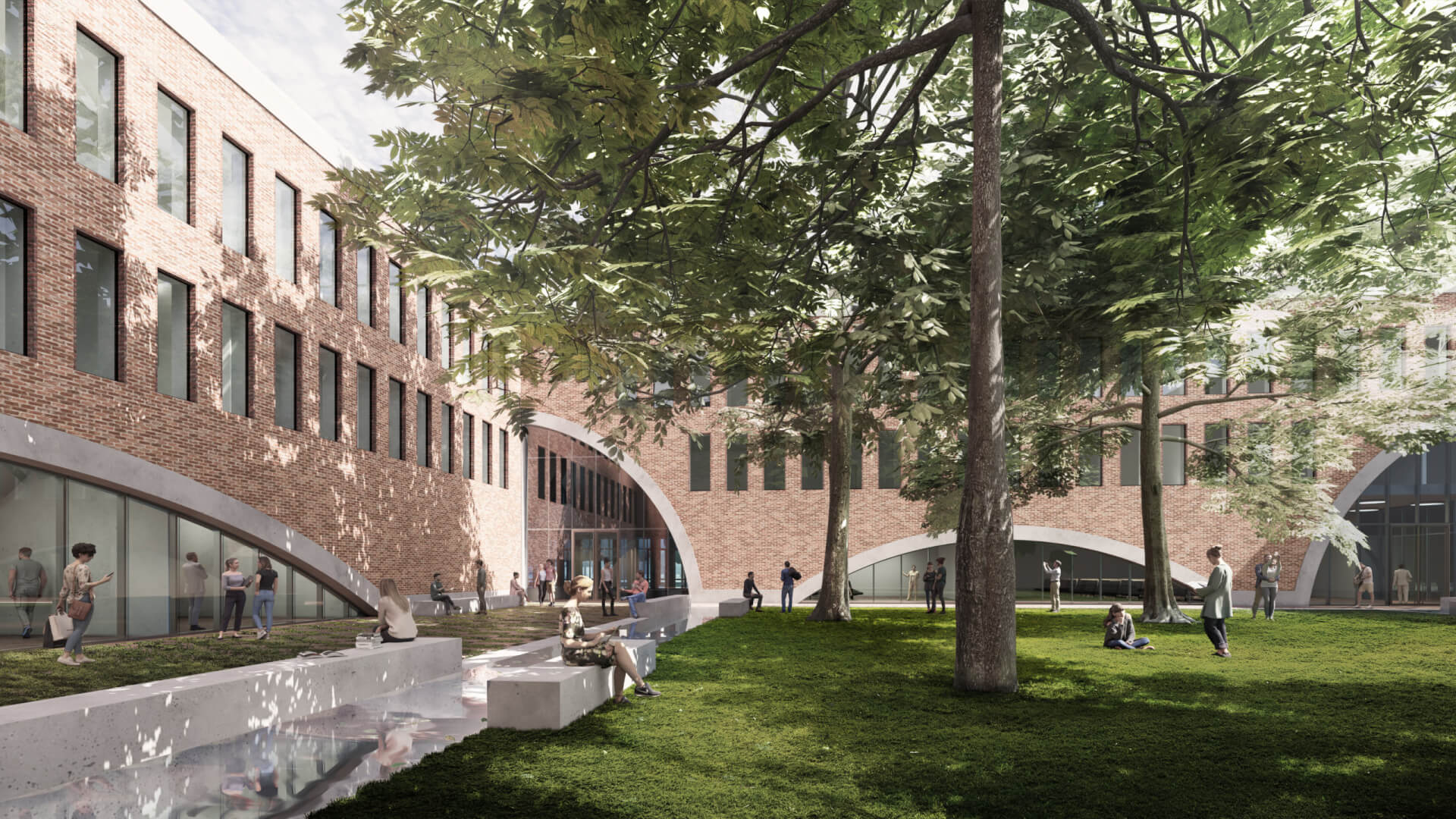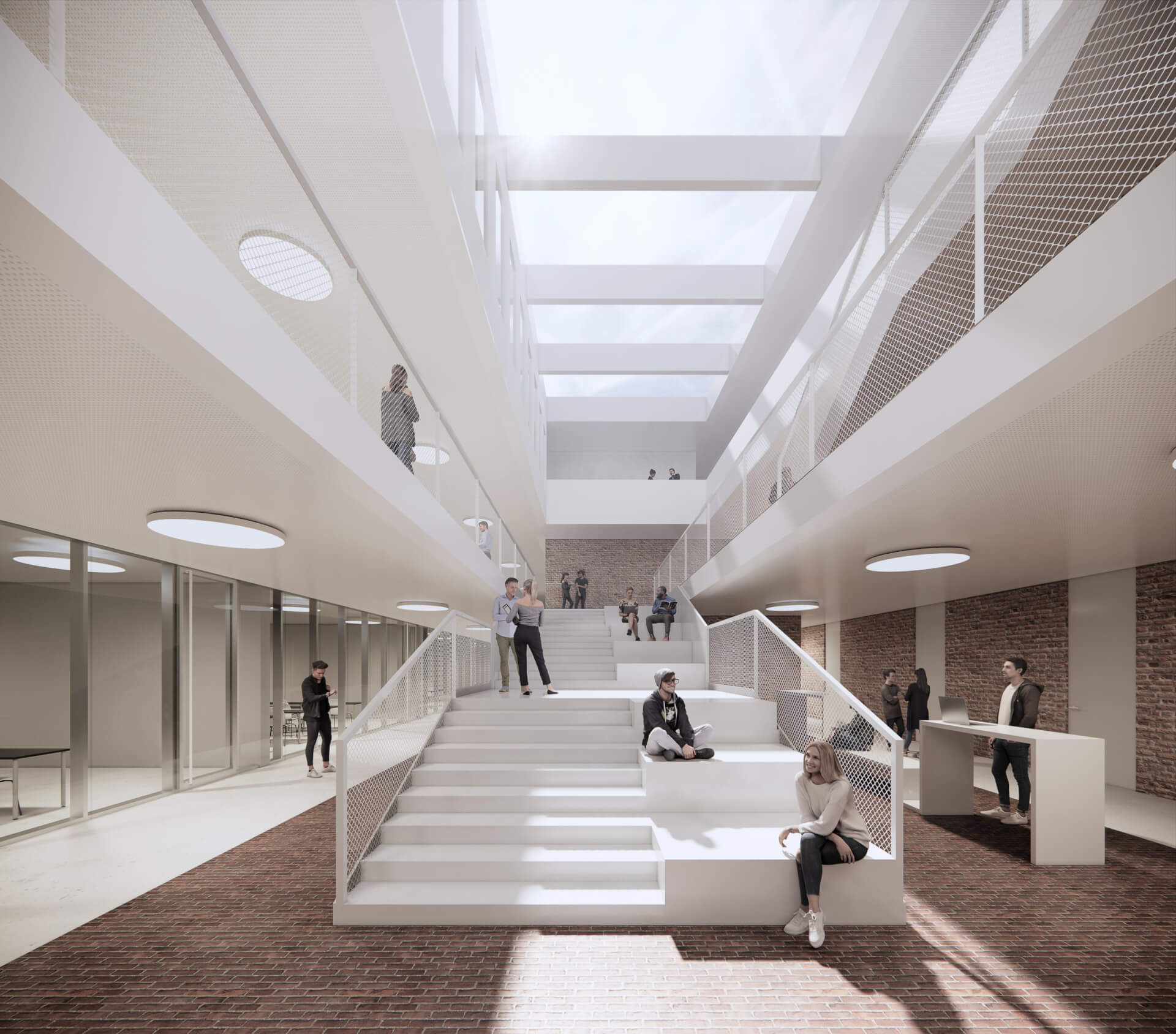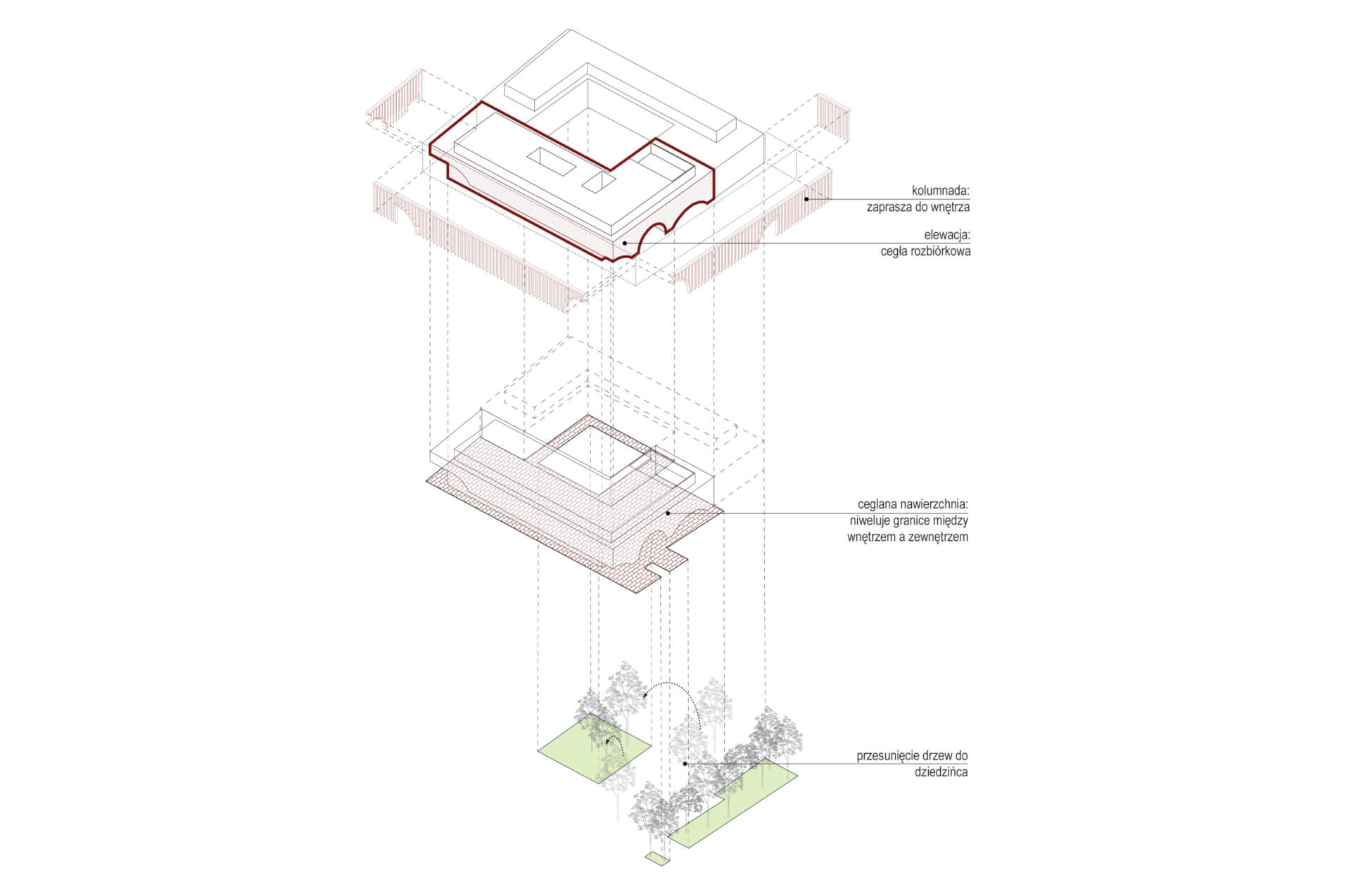warsaw university
The Scientific Revolution has not been a revolution of knowledge. It has been, above all, a revolution of ignorance. The great discovery that launched the Scientific Revolution was the discovery that humans do not know the answers to their most important questions.
-Yuval Noah Harari, Sapiens: A Brief History of Humankind
So wrote Yuval Noah Harari just a few years ago. It’s nothing new. A mere fact. He was not the first or the last to state “I know that I know nothing”. As architects, we too know very little. With such a long history of art and architecture behind us—the Greek agora, Roman forums—we are still figuring out what the university and its community look like and how they function. Despite much experience and years of study, with each project, we ask the same fundamental questions over and over again. Here lies the beauty and the meaning of this work. A ceaseless uncertainty, understatement, a continuous searching, attempts at answers, for architecture is and never should be the final model.
Throughout the pandemic, this knowledge is even more tenuous… Do we shut ourselves off in virtual isolation? Will today’s campus be a mere database, a streaming lecture, a matrix? We hope not. After all, man is a “herd animal” and after the lockdown is lifted, he will return to community life more hungry, even voracious. He will be in need of get-togethers, passionate conversations, and all other freedoms which the virus had taken. Our project will supply flexible space for such activity, both on an urban scale and in functional interiors.
The location of the social sciences and PAN building in the city center, among historic buildings not far from the Vistula River and the newly-designed foot and bike path, makes the city itself a Social Sciences campus. This is a key premise of the project. We don’t think of it as the university “Powiśle Formation”. For us, it is one of the puzzles in the ever-evolving urban fabric, although it also completes a smaller subset which includes the BUW (Warsaw University Library), buildings on Krakowskie Przedmieście, Dobra Street and, in the future, on Bernardyńska Street. Following this line of reasoning, we assumed that the structure be as open as possible, so that the urban hubbub would penetrate the interior without any barriers and that the lively, creative energy could rise within the open spaces. The prospect of this energy penetrating the structure, along with emotions, slogans, protests, or simply just knowledge, will give the building its life-force and meaning. The building’s essence will not change, were it to take on a different role in the future aside from that of today’s university scenario.
Strictly urban-mindedly, we assumed a quarterly plan with regard to the courtyard (the following phase of the construction will be completed within the quarter) and historically-accurate spatial development was recreated, though not quite literally. The frontage along Dobra Street was reinterpreted with a filigree colonnade which on the one hand, references the dimensions of Mariensztat and on the other, axially unifies university facilities with the BUW and the planned building on Bednarska Street. A series of gateways give a characteristic feel to the area in front of the main entrance. This widely accessible, semi-public urban oasis filters out the city hubbub and functions as an identifying element of this new address of the city’s historic alma mater. The space fosters chance encounters and encourages students, area residents, and passers-by to stop and take a breather. The shade of old, preserved trees is a key element of this sanctuary, providing the microcosm with its palpable charm. Serving as an intermediate, transitory space of sorts, no longer a park, but not yet a building, it’s an organic and open part of the city.
This “Good Microcosm”, (from “dobra” meaning “good” in Polish) is the most significant of design decisions on the planning scale. Beyond its function as an urban enclave, this modest park allows, above all, to move the main entrance away from the intersection. It creates a safe and comfortable buffer with an arcade and a brick plaza which penetrates into the building’s interior, as if drawing the city in along with the pulsating matter of students, faculty, residents and curious passers-by.
Along Karowa Street, on the axis of the newly designed pedestrian and bicycle overpass, the brick colonnade employs shadow and light to lead us down an exposed to noontime sunbeams portico, all the way to another entrance. Its rank, though slightly lesser shouldn’t be downplayed, neither in the context of function nor meaning. This inconspicuous site on the city map ties the facility with the Warsaw Cliff, the landmark campus of Krakowskie Przedmieście and is the product of accessibility and inclusivity of the new headquarters of the School of Social Sciences. Lacking this element, Social Sciences wouldn’t truly be… social.
Of consequence is the fact that all entrances, public squares and arcades are consolidated not only with the architecture of this indicative colonnade, but also through the use of a brick surface, all the way through the ground floor of the building. This fusing measure which equalizes the borders between the interior and the exterior results in the city insinuating itself onto the building’s premises.
Following the trail of the ceramic surface, through the main or the smaller lobby, we arrive at the university courtyard. Though invisible from the outside, this site is crucial in the context of urban planning. Its implicit continuation and completion are presumed in the subsequent stage of the project. Carved into the mass, its hollow comprises the school’s courtyard – an archetypal element of an academic establishment such as the Collegium Maius. Safe and isolated from external stimuli, it constitutes a site of reverie or contemplation, but also respite. As part of our concept, the interior patio becomes a green oasis blanketed by the shade of vital old trees which were replanted (moved) from the construction area. The distance is modest and the location of the building block with the garage entirely enclosed within the contour of the ground level and above, results in ample available native ground for the maples and the oaks to continue growing. Though it is said that old trees should never be moved, contemporary techniques appear to yield impressive results. Reverence for these octogenarian specimen is the essence of “humanism in practice” which should certainly concern itself with the needs, happiness, dignity and freedom to grow in one’s social as well as one’s natural environment. On the university patio, one can rest on a bench in close proximity to water, stretch out in the shade on the lawn in an overgrown meadow or catch a few rays of sunlight in another nook of this common expanse. Due to the constraints of the biologically active surface, almost 100% of the courtyard constitutes permeable surfaces. Only here and there, loose bricks were arranged to comprise a trace of the floor sketch.
What is significant is that the greenery in this design is not reflected in the color of the building exterior or the ivy climbing on its facade, though such temptation could appear initially fitting. Recommended foliage is natural, authentic, deep, sturdy, literally rooted in the project itself and it is precisely in this way that the new Social Sciences and PAN building alludes to the noble solutions initiated by the BUW.
The color of the facade is decidedly secondary. It downright doesn’t matter, though it was likewise a subject for quests and experiments that reached far beyond most recent implementations and projects of the “Powiśle Formation”. We scoped for references, forms, timbres and materials across the entire city. The color scheme of the old building, its roof tile, that of Mariensztat and Arkady Kubickiego suggest a warm color palette. Burnt roof tiles, ochres, yellows, even faded pinks and other imperfect plasters on Sowia Street and Mariensztat market square and, at last, the neighborhood of the Powiśle power plant propelled us towards the selection of brick. An imperfect fabric, organic, originating from demolitions and so very precious. What’s more alluring is that this “assembly” of bricks conceals countess mysteries: tales of happiness, passage, joy and human drama which we will never know. The mere fact that the construction material itself can carry an emotional charge suggests an intriguing theme, a tale within itself, a patchwork composed of disparate places, events and human stories.
Isn’t this the perfect raw material for Social Sciences? And who knows, if during the process of designing the new building, we could establish a collaboration with the university and considering the possibilities, together, assemble such a “family tree” of bricks and their storylines which will find a new expression as part of the current facade? Puzzling, albeit tempting…
The architectural form, similar to the building material itself is rooted in the surrounding constructions. Starting from the Kubicki Arcades, through various porticos and walkways of Mariensztat, Krakowskie Przedmieście (House without Rims), or a distant though ready association with the arches of Poniatowski Bridge. These references are not literal, but they appear to prompt numerous allusions to this very site. In effect, they appear to be fitted or built into this urban tissue. The area is interwoven with numerous parks and stretches of greenery, the proximity of which isn’t at all indifferent to the surrounding elevations. They frolic with tree shades, teasing with the seemingly mighty colonnade, gossamer, at once spliced with glass tiles of the building facade. A peculiar dialog between the facility and its surroundings and natural setting, its openness is best expressed by the winter vista of the “Agaton” Square. A uniform net of brick pylon imparts the building’s exterior order and rhythm, at the same time highlighting the transparent and inviting face of the new structure. In essence, along the outline of this development, from adjacent streets, there isn’t a fragment of a wall that would separate this establishment from the surrounding world. The view is practically straight across. Hence, there isn’t going to be any doubt where to warm up with some steaming tea after building a snowman…
The coffee shop is one of the service features which should complement the university’s agenda. Located in the corner of Dobra Street, with an extensive arcade, it will undoubtedly serve as one of the sites of informal discussions or exchanges of thoughts and ideas. The bistro accessible from both, the arcade as well as from the main building’s lobby will likely become the “back room” facilitating a variety of functions taking place in the bustling heart of the building.
The main lobby is an L-shaped expanse that merges all of the building levels together. It is a venue where the academic spirit is readily felt, a question and answer fair throughout final exams or peace and quiet during lazy summer afternoons. It is here that lecturers and audience members of numerous symposiums will crowd and at last, champagne corks will pop on New Year’s Eve. All these storylines will be surely accommodated against this austere backdrop. The plain blocks of the stair case, the overpass and the arching vaults result in a light, coherent space. In its assumption, it may appear rather monumental though stable, but most of all, multi-functional. Essentially, this clamorous junction of thoughts, cultures, people from around the world is the byproduct of this global learning center.
The reception hall is also the key interchange junction of the entire functional structure. It is here that the two primary directions of this two-wing building naturally divide the academics in the southern part from the eastern, administrative wing. The central elevator stem was situated within the bend of both functional wings while maintaining a legible positioning on the ground level. The intrinsic scale of the lobby was derived from the vertical axis of the four-floor expanse through the striking opening of the staircase while descending towards the bottom floor.
The division of functional realms according to floors reflects the respective institutional units in keeping with the facility agenda. The ground floor houses most “open” functions, those that require greatest access: services, the library, study hall along with a considerable number of lecture halls which can be effectively utilized for the needs of academic conferences. All scholastic facilities are located on the 2nd and 3rd floors: academic, didactic and administrative. The 4th floor, as the highest tier of the building has been allocated to house the PAN Institute of Philosophy and Sociology. Basement floors provide complementary space consisting of computer classrooms, storage and housekeeping premises, technical facilities in addition to a garage with a dedicated bicycle parking area.
Horizontally, this concerted division of functions would undoubtedly have a rather disjoining impact. The construction called for counterbalance, which became the M-shaped spaces – lounges. Their significance, as the fundamental spatial unifying force of the academic wing possesses not only a spacial dimension, but mainly a social one. The broad staircase that is both functional and recreational connects the 2nd and 3rd floors, the opening of the 4th floor along with transit mezzanines, in essence, represent a type of agora or a central public space. Spaces pulsing with campus activity, places that bring us together.
Demolition brick – architectural recycling. An establishment of public utility, an academic facility, a meeting place for the enlightened, those who think more and know more. Does this make the decision about constructing another building any easier? New technologies, energy-efficient solutions and passive, renewable energy sources – it all allows us to build smarter. Is it perhaps enough to be just eco-friendly? Is it only an excuse not to look deeper?
The dilemmas of our civilization, eco-consciousness and concern for the environment are also architectural conundrums. If we are switching to bicycles and limiting the number of products around us, but we process more of them, then even more so, we must build smarter. The brick colonnade presents a tempting archetype. In this instance, it is above all a display of architectural recycling. Demolition brick is a construction material no longer available. Essential carbon emission has already taken place, though the variety of textures along with pollution created through time will confer on architecture a broader temporal context – this colonnade already exists!
 all
all 